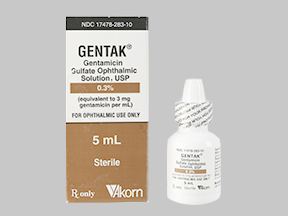
Gentamicin Sulfate Coupons & Savings Card – Discount Prices from $16.38
Generic for: Gentak
My prescription
Edit
15ML of 0.3%, Gentamicin Sulfate (1 Bottle)
Select pharmacy

CVS
$21.38
COUPON PRICE
Walmart
$16.38
COUPON PRICE
Walgreens
$20.04
COUPON PRICE
Albertsons
$38.94
COUPON PRICEGentamicin Sulfate savings card
Show this card to your pharmacist
Walmart
$16.38
BIN
ID
PCN
GRP
019876
LH7AD00978
CHIPPO
LHX
Powered by
More prescriptions for skin infection
More prescriptions for skin infection
Gentamicin Sulfate dosage forms
Dosage Quantity Price from Per unit 1GM 1 Bottle $1.01 $1.01 1GM 2 Bottles $12.15 $6.08 1GM 3 Bottles $27.72 $9.24 15ML of 0.3% 1 Bottle $16.38 $16.38 15ML of 0.3% 2 Bottles $24.75 $12.38 15ML of 0.3% 3 Bottles $28.13 $9.38
| Dosage | Quantity | Price from | Per unit |
|---|---|---|---|
| 1GM | 1 Bottle | $1.01 | $1.01 |
| 1GM | 2 Bottles | $12.15 | $6.08 |
| 1GM | 3 Bottles | $27.72 | $9.24 |
| 15ML of 0.3% | 1 Bottle | $16.38 | $16.38 |
| 15ML of 0.3% | 2 Bottles | $24.75 | $12.38 |
| 15ML of 0.3% | 3 Bottles | $28.13 | $9.38 |
Gentamicin Sulfate Warnings
The following safety information outlines crucial warnings and potential risks associated with the use of this medication. Please read through them carefully and consult your healthcare provider if you have any questions or concerns.
New Infection Risk: Using this medication for an extended period can lead to new infections caused by fungi or bacteria that may be resistant to gentamicin (Gentak). Avoid using the medication longer than prescribed. Contact your healthcare provider if you notice symptoms of a new infection or if your initial symptoms do not improve.
Irritation or Allergic Reactions: Gentamicin (Gentak) may cause eye irritation. In rare instances, it can trigger an allergic reaction. If you experience severe or persistent irritation, pain, rash, or redness, contact your healthcare provider immediately. Inform your provider if you have a history of allergic reactions to other aminoglycoside antibiotics, such as tobramycin (Tobrex).
Slower Healing (Ointment Form): Eye ointments containing gentamicin (Gentak) can slow down the healing of the cornea, the eye's protective covering. Ensure you follow up with your healthcare provider to monitor your eye's healing progress.
Contamination Risk: There is a risk of bacterial contamination with eyedrops, potentially leading to eye infections. Always wash your hands before each dose. Avoid touching the container tip with your eye, hands, or any surface, and ensure you replace the cap after each use.
Please adhere to these precautions to ensure safe use of this medication.
Gentamicin Sulfate Side Effects
Common side effects:
- Skin irritation
- Redness
- Itching
- Eye burning or irritation
- Pink eye not caused by bacteria
- Eye redness
Less common but important to monitor:
- Other skin infections (fungal or bacterial)
Serious side effects:
- Rash
- Itching/swelling of the face, tongue, or throat
- Severe dizziness
- Trouble breathing
Gentamicin Sulfate Interactions
When taking gentamicin sulfate, it's important to be aware of potential interactions with other medications, as these can affect its effectiveness or increase the risk of side effects. Here are some key interactions to consider:
1. Other Antibiotics: Combining gentamicin with certain antibiotics, such as other aminoglycosides (e.g., Amikacin, Neomycin) or cephalosporins, can heighten the risk of kidney damage. It's advisable to avoid using these medications together unless specifically directed by a healthcare provider.
2. Diuretics: Potent diuretics like Furosemide or Ethacrynic Acid may amplify the ototoxic effects of gentamicin, potentially leading to hearing loss. Additionally, when administered intravenously, these diuretics can alter gentamicin concentrations in the body, increasing toxicity risks. Concurrent use should be approached with caution.
3. Neuromuscular Blocking Agents: Medications used to relax muscles during surgery, such as succinylcholine or tubocurarine, can have enhanced effects when taken with gentamicin. This combination may lead to prolonged muscle relaxation and, in severe cases, respiratory paralysis. Close monitoring is essential if these drugs are used together.
4. Non-Steroidal Anti-Inflammatory Drugs (NSAIDs): NSAIDs like Indomethacin may decrease the excretion rate of gentamicin, resulting in higher levels of the antibiotic in the body. This can increase the risk of toxicity, so careful monitoring is recommended when these medications are used concurrently.
5. Penicillins: When gentamicin is mixed with penicillins in the same intravenous solution, the antibiotic can be inactivated, reducing its effectiveness. To prevent this, it's important to administer these medications separately and avoid combining them in the same IV fluid.
6. Magnesium Salts: Using gentamicin with magnesium-containing medications can lead to neuromuscular weakness. Patients should be monitored for signs of respiratory dysfunction and muscle weakness when these are used together.
Always inform your healthcare provider about all medications you're currently taking, including over-the-counter drugs and supplements, to ensure safe and effective use of gentamicin sulfate.
